
Ajman is gradually embracing sustainable real estate development as one of the UAE's growing emirates. Although 2024 presents a fresh set of opportunities and difficulties, it is also the year that plans that reflect environmental responsibility must be developed to meet the growing demand for residential and commercial real estate. Here's how this year's sustainable real estate development in Ajman is guaranteed.
Getting Greener with Building Policies

Green building practices are essential to the development of sustainable property in Ajman. Eco-friendly materials and technology can significantly reduce environmental impacts in new constructions. This should be on:
- Energy Efficiency: Energy-efficient systems, such as solar panels and LED lighting, minimize energy consumption and carbon footprints. Smart home technologies can optimize energy use, attaining long-term savings for its residents.
- Water Conservation: Low-flow toilets, showers, faucets, and connections to rainwater harvesting systems save water, a precious resource in the UAE's desert climate. Grounds landscaping with native, drought-resistant plants similarly reduces water use.
- Recycled Materials and Locally Sourced Materials: Using materials from the recycling stream and locally sourced materials minimizes waste and provides immediate economic stimulus in local communities. Better sustainable choices include using bamboo, reclaimed wood, and recycled metal.
Innovative Design and Planning

Sustainable real estate development is built on creative planning and design. Developers in Ajman are asked to embrace designs that promote environmental sustainability and community well-being. These include passive designs, which allow buildings to strategically utilize natural ventilation and orientation to reduce their dependency on artificial heating and cooling; better windows and enough insulation to allow natural light and air to enter the interior space.
- Mixed-Use Developments: Long commutes are less likely to be necessary for a development that combines residential, commercial, and recreational areas, which would significantly lessen pollution and traffic congestion. Additionally, mixed-use complexes produce thriving, independent communities.
- Public Spaces and Green Areas: In property development, parks, gardens, and public spaces encourage biodiversity and provide residents with leisure and other recreational facilities to lead good quality of life.
Smart Integration
There are many trends concerning property development in 2024, one of the most important being smart technologies. These can be applied positively in Ajman to contribute to sustainable efficiency.
- Smart Home Systems integrates automation in lighting, climate control, and home security systems. They are available to the owner to provide convenience while optimizing energy and resources. The system can be easily customized according to the customer's preferences, which leads to good living habits.
- IoE and Data Analytics: IoE and data analytics make real-time tracking of energy consumed, water used, and waste produced possible. This helps develop a data-driven culture of maintenance and resource efficiency.
- Sustainable Infrastructure: Smart lines, electric vehicle charging stations, and introducing energy-efficient public transportation are all part of sustainable infrastructure. These are intended to support the city of Ajman's development strategy and keep it in line with the broader sustainability schedule.
Community Involvement and Education Development

An essential characteristic of sustainable property development trends is community engagement and education to ensure commitment from the residents and stakeholders in the long run:
- Awareness Programs: Workshops and seminars engage residents in campaigns to raise their awareness of sustainable living practices. Topics can include energy conservation, waste reduction, and environmentally friendly transport.
- Incentives for Sustainable Practices: Incentives such as utility rebates or subsidies to install renewable energy systems encourage people to adopt sustainability. These incentives usually lead to more community participation.
- Collaborative Planning: Community participation in planning and development will ensure that projects actually meet the locality's needs. Collaborative planning is a consideration in building ownership and maintaining sustainable environments.
Regulatory Compliance and Incentives
Besides, the regulations and government facilitate the sustainable development of the properties in Ajman.
- Adherence to Green Building Codes: The developers must follow Ajman's green building regulations, which include waste management, water conservation, and energy efficiency. All of the emirate's eligible developments will contribute to meeting sustainability requirements.
- Government Incentives: The government of Ajman provides some incentives for sustainable development, including a tax break, grant, and more. Developers can use such benefits to offset initial investment costs or make their projects environment-friendly.
- Sustainable Certifications: LEED or Estidama certifications are proof of a commitment to sustainability. Properties with these certifications are more marketable and valuable.
Conclusion
The overall strategy that Ajman would need to ensure sustainable property development this year would combine several methods. Developers need to emphasize green building practices. Thus, energy-efficient systems and water-saving technologies, for example, have to be followed to the letter to reduce environmental impact. Innovative design, including natural light and ventilation, can make buildings much more comfortable without keeping one's energy consumption high.










Comments (0)
Leave a comment